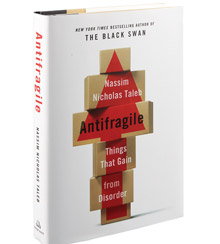Betting against the Fragilistas
A review of Antifragile: Things That Gain from Disorder, by Nassim Nicholas Taleb.
(originally published by Booz & Company)Antifragile: Things That Gain from Disorder
by Nassim Nicholas Taleb
Random House, 2012
Nassim Nicholas Taleb is a reflective practitioner—a man with the mind of a scholar and the intestinal fortitude of a trader. His book The Black Swan: The Impact of the Highly Improbable (Random House, 2007), in which he pointed out the vulnerability of the financial system to improbable, unpredictable events, became a runaway bestseller. His quirkily written perspective anticipated the meltdown of 2008.
Disastrous events also arrived along with Taleb’s new book. Antifragile: Things That Gain from Disorder examines the characteristics of systems that thrive on volatility, as opposed to fragile systems that are highly vulnerable to fluctuations. It was published just weeks after Superstorm Sandy ravaged the northeast coast of the United States, amid discussion about how to protect New York City and other places from future disasters.
The thick tome, which the author regards as his central work, is organized into seven books. It is a sprawling paean to the practitioner’s know-how, what the Greeks called techne, versus academic “know-what,” or episteme. “I’d rather be dumb and antifragile than extremely smart and fragile, any time,” Taleb declares in the book’s prologue. This is because antifragility allows us “to do things without understanding them—and do them well.” Even better, antifragile systems don’t just survive shocks, they prosper from them. Shocks stimulate the evolution and improvement of such systems.
It is also in the prologue that Taleb makes first mention of the fragilista, his favorite neologism—among the book’s innumerable neologisms—for the “naive rationalists” who, in quest of benefits that are “small and visible,” construct systems with side effects that are “potentially severe and invisible.” Fragilistas, a group into which Taleb seems to lump most economists and business school professors, believe in normal, bell-shaped (Gaussian) distributions of events and are continually surprised when phenomena follow exponential and power laws.
In the books that follow, Taleb details the concept of antifragility and demonstrates how it is present in all systems that survive. Fragility at one level of these systems leads to antifragility at the level above. Thus, to give a trivial example, restaurants are notoriously fragile institutions that tend to come and go suddenly. But this constant churn results in more choice and improved quality in the marketplace. The problem, says Taleb, is that in modern times we have become increasingly preoccupied with prediction, and blind to the value of antifragility. As a result, iatrogenic damage (harm caused by well-meaning interventions) has become ubiquitous. Antibiotics spawn superbugs; the propping up of dictators leads to violent revolution; and, as Superstorm Sandy demonstrated, the construction of permanent structures on impermanent shorelines becomes a sure prescription for mass destruction.
Taleb describes himself as a skeptical empiricist and a disciple of Seneca, the Stoic philosopher. We tend to think of the Stoics as being able to withstand life’s vicissitudes, but Taleb says they are always looking for situational asymmetries. This quest is the essence of an antifragile strategy: to identify and exploit options in which you can bet against the fragilistas with little to lose and much to gain.
Taleb classifies such a strategy as a convex transformation because it combines an aggressive stance toward upside opportunities with a healthy paranoia about large negative outcomes. Conversely, the fragilistas develop and promote concave transformations that publicize modest upside gains, but ignore the possibility of catastrophic risks. Unsurprisingly, Taleb thinks that the fragilistas are the suckers to bet against, a view that explains an investment strategy he recommends: shorting the stocks of companies touted in books like Jim Collins’s Good to Great because they have nowhere to go but down.
Book VI, titled “Via Negativa,” is one of the most insightful sections of Antifragile. In it, Taleb points out that our knowledge of what does not work is often greater than our knowledge of what does work. In addition, as a forecast reaches farther into the future, it is easier to predict what won’t survive than to predict what will survive. He also explains that when it comes to perishable things (like people), the young can be expected to outlive the old. But with nonperishables (like ideas), the situation is reversed: The older they get, the longer they can be expected to persist. So, if we are seeking a lasting education, we should give more weight to the classics, because the ideas they contain have proven useful over many generations, as opposed to new ideas, which are more likely to fall by the wayside as time passes.
In the final analysis, Taleb’s perspective is fundamentally sound. Life itself is antifragile, evolving in response to volatility. Perhaps that is the most compelling reason to be wary of abstractions and rely on experiential and practical evidence as the most reliable guides to action. As Yogi Berra put it: “In theory, there is no difference between theory and practice; in practice, there is.” ![]()
Author profile:
- David K. Hurst is a contributing editor of strategy+business. His latest book is The New Ecology of Leadership: Business Mastery in a Chaotic World (Columbia Business School Publishing, 2012).


